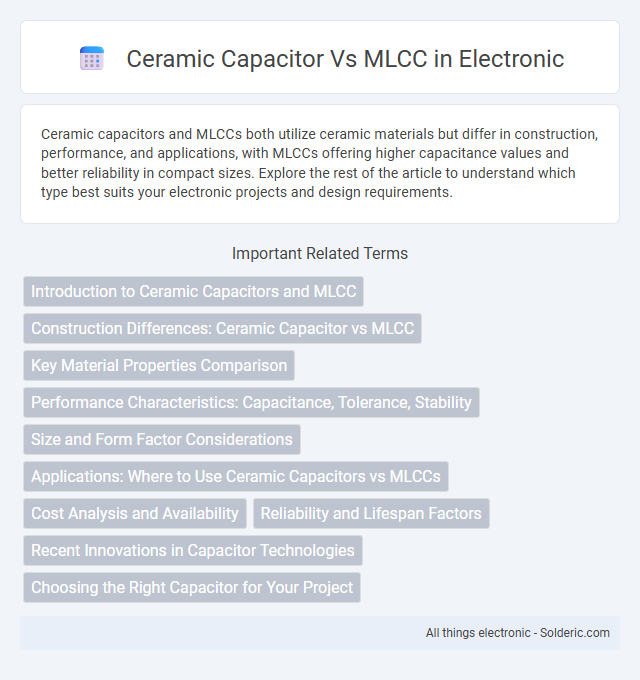Ceramic capacitors and MLCCs both utilize ceramic materials but differ in construction, performance, and applications, with MLCCs offering higher capacitance values and better reliability in compact sizes. Explore the rest of the article to understand which type best suits your electronic projects and design requirements.
Comparison Table
| Feature | Ceramic Capacitor | MLCC (Multilayer Ceramic Capacitor) |
|---|---|---|
| Type | Single-layer or few layers | Multiple ceramic layers stacked |
| Capacitance Range | pF to uF | pF to high uF |
| Size | Generally larger | Compact, small size |
| Voltage Rating | Low to medium | Wide range, up to high voltage |
| Frequency Response | Good for high frequency | Excellent high frequency performance |
| Stability | Stable | Stable with low ESR |
| Applications | General filtering, coupling | Decoupling, bypassing, filtering |
| Cost | Lower cost for simple types | Cost-effective for high volume |
Introduction to Ceramic Capacitors and MLCC
Ceramic capacitors, including Multilayer Ceramic Capacitors (MLCCs), are widely used passive components known for their stability, low inductance, and high capacitance in small volumes. MLCCs consist of multiple ceramic layers stacked with metal electrodes, enabling higher capacitance and improved performance compared to single-layer ceramic capacitors. These capacitors are essential in electronic circuits for filtering, decoupling, and energy storage due to their reliability and cost-effectiveness.
Construction Differences: Ceramic Capacitor vs MLCC
Ceramic capacitors consist of a single ceramic dielectric layer sandwiched between two electrodes, whereas MLCCs (Multilayer Ceramic Capacitors) are constructed with multiple alternating layers of ceramic dielectric and metal electrodes stacked together. This multilayer structure in MLCCs increases capacitance density and allows for smaller physical sizes compared to single-layer ceramic capacitors. When choosing capacitors for your electronic designs, understanding these construction differences helps optimize performance and space efficiency.
Key Material Properties Comparison
Ceramic capacitors and MLCCs (Multi-Layer Ceramic Capacitors) both utilize ceramic dielectric materials but differ in their construction and performance characteristics. Ceramic capacitors typically use a single-layer ceramic dielectric, offering stability and reliability for general applications, while MLCCs consist of multiple thin ceramic layers stacked together, providing higher capacitance and better voltage ratings in a compact form. Your choice depends on the key material properties such as dielectric constant, temperature stability, and frequency response, where MLCCs generally excel due to their multilayer design and advanced ceramic formulations.
Performance Characteristics: Capacitance, Tolerance, Stability
Ceramic capacitors, particularly multilayer ceramic capacitors (MLCCs), offer high capacitance values in compact sizes, making them ideal for various electronic applications. MLCCs generally exhibit tighter capacitance tolerance and superior temperature stability compared to traditional single-layer ceramic capacitors, ensuring consistent performance in fluctuating environments. Your choice of capacitor should consider the specific stability and tolerance requirements to optimize circuit reliability and efficiency.
Size and Form Factor Considerations
MLCCs (Multilayer Ceramic Capacitors) offer a compact size and thin form factor, making them ideal for high-density circuit designs and space-constrained applications. Ceramic capacitors, while similar in material, come in various sizes but typically are larger and less optimized for miniaturization compared to MLCCs. Your choice depends on the required capacitance and available PCB real estate, with MLCCs preferred when minimizing size and maintaining performance is critical.
Applications: Where to Use Ceramic Capacitors vs MLCCs
Ceramic capacitors, especially Class 1 types, are ideal for high-frequency applications such as RF circuits and resonators due to their low loss and stability, while MLCCs (Multilayer Ceramic Capacitors) are preferred in power supply decoupling, filtering, and general-purpose circuit board designs because of their compact size and high capacitance density. Your choice depends on the electrical requirements; MLCCs handle higher capacitance values and voltage ratings suitable for bulk energy storage, whereas single-layer ceramic capacitors excel in precision timing and frequency-sensitive applications. Understanding the differences in dielectric materials and construction helps optimize performance in consumer electronics, automotive systems, and industrial devices.
Cost Analysis and Availability
Ceramic capacitors generally offer lower costs for bulk applications due to simpler manufacturing processes compared to MLCCs (Multilayer Ceramic Capacitors), which incorporate multiple layers for enhanced capacitance and reliability. MLCCs often provide better performance but come at a higher price point, influenced by increased material complexity and production precision. Availability of ceramic capacitors is broader with abundant suppliers and standardized specifications, while MLCCs may face supply constraints during high demand periods due to intricate production requirements and specialized usage in advanced electronics.
Reliability and Lifespan Factors
Ceramic capacitors, particularly multi-layer ceramic capacitors (MLCCs), are known for high reliability due to their solid dielectric structure and low equivalent series resistance (ESR). MLCC reliability depends on factors such as dielectric material quality, electrode design, and operating conditions including voltage and temperature stress. Lifespan is influenced by mechanical cracks from thermal cycling and voltage derating, with careful material engineering extending MLCC operational life in demanding electronic applications.
Recent Innovations in Capacitor Technologies
Recent innovations in capacitor technologies have significantly improved the performance of ceramic capacitors versus MLCCs, with advancements like high-k dielectric materials enhancing capacitance density and temperature stability. Modified multilayer ceramic capacitors (MLCCs) now feature improved electrode designs and nano-scale grain structures that reduce equivalent series resistance (ESR) and increase reliability in high-frequency applications. These developments provide you with capacitors that offer superior energy storage, miniaturization, and longevity for modern electronics.
Choosing the Right Capacitor for Your Project
Ceramic capacitors and MLCCs differ primarily in construction and performance, with MLCCs being a subtype of ceramic capacitors known for their multilayer design, offering higher capacitance in a compact size. When choosing the right capacitor for your project, consider factors such as voltage rating, capacitance stability, frequency response, and operating temperature, as MLCCs generally provide better high-frequency characteristics and lower equivalent series resistance (ESR). Your selection should align with the specific electrical requirements and environmental conditions to ensure optimal circuit performance.
ceramic capacitor vs MLCC Infographic

 solderic.com
solderic.com